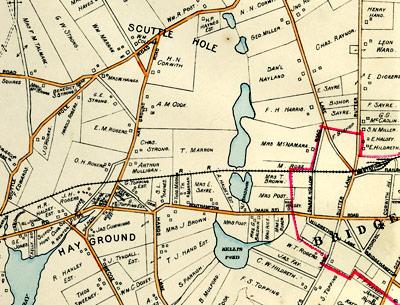Nature Notes: Land of Ponds

Before I begin, I received an inquiry from Jim Monaco, a book publisher who lives in the south Sag Harbor hills, about deer and the underbrush. He has no ladyslippers, lilies, or other pretty flowers in the groundcover of his nearby woods, only huckleberries and blueberries. True, deer eat orchids, lilies, and other pretty flowers, as do rabbits, squirrels, and other wild beasties in our area. But it is the blueberries and huckleberries that filter nutrients and other dissolved constituents carried in the rainwater that percolates down through the soil layers and into the fresh glacial aquifer, a source of much of our drinking water on the East End.
Jim also observed that the tick population in his neck of the woods is way down. I’ve heard similar stories from hikers in Montauk and elsewhere on the South Fork. Wouldn’t it be grand if some new disease or predator is hitting on the local tick population and knocking them off? It remains to be seen. On the other hand, the mosquitoes are hitting on us fast and furiously throughout much of the area. Prolonged dryness is the only situation that does them in, save for the application of pesticides.
And it is anything but dry. The August rains have already raised the level of water table ponds and kept perched ponds in business, as well. In a column on ponds two weeks ago, I failed to mention two of the most important and unique pond systems on the South Fork, the two long pond systems that run from north to south. One of them links the Peconic Estuary with the Atlantic Ocean, the other comes close. The chain of ponds between Sagaponack and Sag Harbor is the largest and the most ponded of these two systems. Starting with Otter Pond on the north, no less than 13 ponds, some of them mere dimples, link the ocean with the bays. In actuality, Otter Pond, the only one that is regularly tidal, doesn’t share the same watershed as the other 12, but it probably did in the near geologic past.
After Otter Pond comes Round Pond, Lily Pond, Long Pond, Little Long Pond, Crooked Pond, Slate Pond, Black Pond, Little Poxabogue Pond, Poxabogue Pond, Jeremy’s Hole, and, lastly, Sagg Pond, which is a coastal lagoon that is frequently opened to the ocean. Two of the dimple ponds are Fore and Aft, named so by some early Sag Harbor mariners, no doubt.
In dry times, such as the record drought of the 1960s, some of these ponds, among them Poxabogue and Round Ponds, almost dry up completely. During very wet periods, they overflow their banks and almost become one.
The ponds north of the divide recharge water to the north. Long Pond is the largest of these and in wet years pours out into Ligonee Brook, which different from the ocean’s winter flounder stock. It remains to be seen.
The other long pond system rises north of Scuttle Hole Road in Bridgehampton, just south of the moraine. Its watershed is completely southerly directed, ending up at Kellis Pond south of the Bridgehampton Commons. From north to south Short’s Pond starts it off, then comes Haines Pond, Goldfish Pond, Long Pond, Little Long Pond, and finally Kellis Pond, south of the highway. This other Long Pond, as well as Kellis Pond, are approximately the size of the Sag Harbor Long Pond. This second Little Long Pond is mostly covered by woody shrubs. As such, it is a favorite of wood ducks.
Both pond systems, especially those without big fish populations, are host to the eastern tiger salamander, which is New York State-endangered. They also contain some interesting native fish such as pumpkinseeds, yellow perch, and mudminnows. They are great waterfowl gathering areas, particularly Short’s Pond next to the Atlantic Golf Course, and have many rare plant species, some of which have been overrun with that rampant enemy from Eurasia, Phragmites australis. Some of these rare plant species, such as the rose coreopsis, only appear when the pond levels are low and there are wide areas of exposed shores through the growing season.
Fortunately, the bottoms (and the ponds on top of them) are publicly owned, that is, by the Southampton Town Trustees, that august body which was given the rights to all of the freshwater ponds in the town by way of the Dongan Patent issued by the New York governor while the British were still in control of America.
I also forgot to mention a third chain of ponds, the Seven Ponds of Water Mill, which are in the greater Mecox Bay watershed and, if two ponds can make up a chain, a fourth — Big and Little Fresh Ponds in the hamlet of North Sea. Two ponds in these last two systems receive spawning alewives from adjacent seawaters: Mill Pond by way of Mecox Bay and the Atlantic Ocean and Big Fresh Pond by way of an overflow stream to North Sea Harbor. This latter breeding population is one of the oldest in New York State and one of the very largest. Year after year it never fails to produce; at times hundreds of thousands of fingerling alewives run to the sea come August and September.
Surely, if Minnesota is America’s Land of Lakes, Long Island’s South Fork might be her Land of Ponds!
